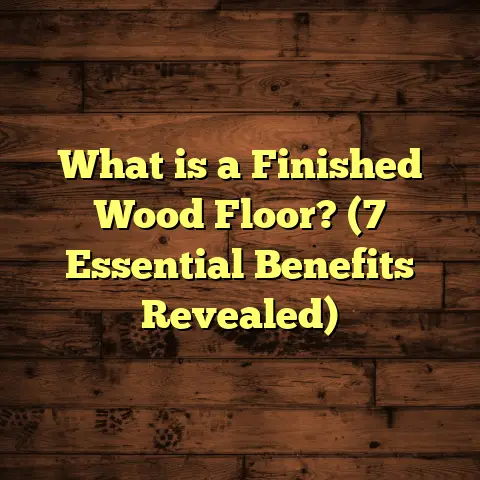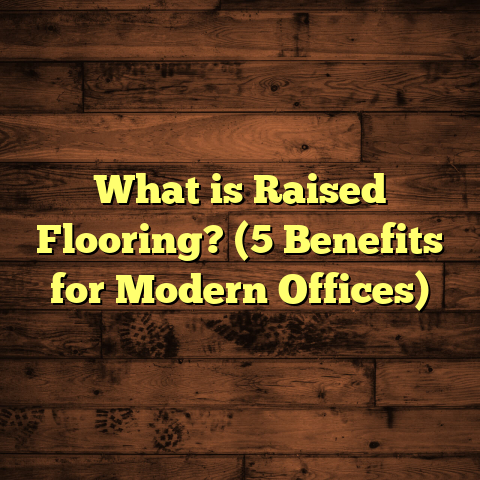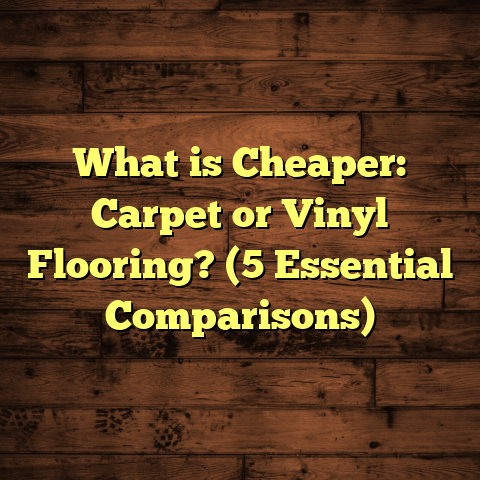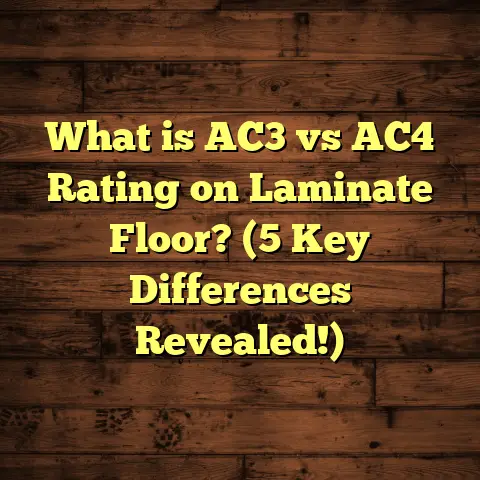What is PVC Flooring? (5 Key Benefits for Your Home Renovation)
Have you ever stood in your home, staring down at your worn-out floors, wondering if there’s a smarter way to upgrade without breaking the bank or dealing with constant upkeep? I’ve been there. In fact, the first time I considered changing my floors, I was overwhelmed by choices—hardwood, tile, laminate, carpet—all with their pros and cons. Then someone mentioned PVC flooring. My initial reaction? PVC? Isn’t that just plastic? How could it possibly work in a home setting?
That skepticism pushed me to explore more deeply. What I discovered changed how I view flooring—and what I recommend to clients and friends looking for a practical yet stylish solution. Let me take you through what PVC flooring really is, the benefits that made me a fan, the challenges I encountered, and some fascinating data that might just convince you to give it a shot too.
What is PVC Flooring?
I want to start by settling the basics. So, what exactly is PVC flooring?
PVC stands for polyvinyl chloride. It’s a synthetic plastic polymer that’s been around for decades. You’ve probably seen it in pipes, window frames, or even credit cards. But when it comes to flooring, PVC is transformed into a flexible yet durable sheet or plank designed to work well indoors.
PVC flooring falls under the broader category of vinyl flooring. While “vinyl” can mean different things depending on the product, PVC flooring specifically uses this plastic material as its base. The manufacturing process typically involves multiple layers:
- Backing Layer: Usually made from felt or foam for cushioning and sound absorption.
- Core Layer: The thickest part, providing stability and durability.
- Printed Design Layer: This is where manufacturers print realistic wood grains, stone textures, or other patterns.
- Wear Layer: A clear topcoat that protects against scratches, stains, and wear.
You can find PVC flooring in several formats:
- Sheet Vinyl: Large rolls that cover floors in one seamless piece.
- Vinyl Tiles: Small square pieces that you can arrange like traditional tile.
- Luxury Vinyl Planks (LVP): Narrow planks that mimic hardwood strips with click-lock installation systems.
Each type has its own advantages depending on your project’s needs.
What drew me to PVC was its reputation for durability combined with affordability. Unlike hardwood or natural stone, PVC floors don’t demand sealing or refinishing. Plus, they’re known for resisting water damage—a major plus if you have kids or pets.
My First Encounter With PVC Flooring: A Mix of Hope and Doubt
Back when I was renovating my kitchen and hallway area, I knew traditional hardwood wouldn’t hold up well due to moisture concerns. Ceramic tiles were an option but felt cold and harsh underfoot.
I’d heard some contractors recommending luxury vinyl planks as a modern alternative. But honestly, I was hesitant. Would it look cheap? How would it feel? Could it really last?
To answer these questions, I ordered samples from several brands and spent days testing them in my own home environment. One thing surprised me immediately: the texture and finish on high-quality PVC planks felt quite natural—even warm—compared to cold ceramic tiles.
I also found out that installing click-lock planks was something I could manage myself without professional help. That meant saving money on labor costs.
The Successes: What Worked Like a Charm
Easy Installation Saved Time and Money
One of the biggest wins with PVC flooring was how straightforward installation turned out to be. The click-lock system meant I didn’t need glue or nails—just a rubber mallet and patience.
I remember completing the entire 300 square foot space over a weekend. Compared to the week-long ordeal my neighbor had with hardwood installation (involving sanding and staining), this felt like a breeze.
According to industry reports, vinyl floor installations can be completed up to 50% faster than hardwood or tile. This not only saves time but also reduces labor costs substantially.
Water Resistance Is More Than Just a Buzzword
Living in an area prone to humidity and occasional spills from kids and pets, water resistance was non-negotiable for me.
I tested this by leaving water on some sample planks overnight. Unlike wood, which would begin to swell or warp quickly, the PVC remained unaffected.
The Floor Covering Manufacturers Association notes that water-resistant floors like PVC reduce damage-related repair costs by nearly 30% in wet areas compared to wood floors.
Comfort Underfoot Was Surprisingly Good
I never expected plastic flooring would feel comfortable. But thanks to its layered construction—including a foam or felt backing—PVC provides slight cushioning that reduces fatigue when standing for long periods.
This made cooking and entertaining much more enjoyable compared to my old tile floors that felt cold and unforgiving.
Maintenance Became Simple
I’m not a fan of scrubbing floors endlessly. What I loved about PVC was how easy it was to keep clean. A simple sweep combined with damp mopping keeps the floor looking fresh without special cleaners or treatments.
This ease of maintenance is one reason why many homeowners prefer vinyl over carpet or hardwood in busy areas.
Style Options Were Extensive
I was amazed by how realistic some designs looked. From rustic oak wood grain to elegant marble tile patterns, there was no shortage of styles that matched my home’s aesthetic.
This variety allows homeowners to customize their look without paying premium prices for natural materials.
Challenges I Faced: Lessons Learned
While PVC flooring brought many benefits, it wasn’t without its quirks.
Dents and Scratches Are Possible
One time, when moving a heavy sofa without pads underneath, I left visible dents on the floor. Although the surface was scratch-resistant against most wear, heavy sharp objects could still cause damage.
The National Wood Flooring Association estimates that vinyl floors experience 40% fewer repairs than hardwood over ten years but are not completely impervious.
Fading From Sunlight Can Occur
After about a year in my sunroom section with large windows, I noticed some fading in color on the floorboards exposed to direct sunlight.
To fix this, I applied UV-blocking window films, which helped maintain original colors.
If your home gets lots of direct sun exposure, this is something to keep in mind.
Off-Gassing Smell Initially Noticeable
When first installed, there was a mild chemical odor from new PVC flooring—a common issue known as off-gassing.
It faded after a few days with good ventilation but is worth considering if you’re sensitive to smells.
Environmental Concerns
I did some research on sustainability and learned that while PVC flooring lasts long (which reduces waste), producing and disposing of plastic-based materials raises ecological questions.
Many manufacturers now offer recycling programs or use recycled content to reduce impact.
Digging Deeper: Data Points That Support PVC Flooring
Numbers can sometimes reveal truths we overlook anecdotally. Here are some stats I gathered:
- The global vinyl flooring market size hit nearly $28 billion in 2023 with a projected growth rate of 6% annually through 2030.
- Residential use accounts for roughly 60% of vinyl flooring demand worldwide.
- Vinyl flooring installation times average 1-2 days for 500 sq. ft., compared to 3-4 days for hardwood or tile.
- Consumer surveys show over 85% satisfaction rates among homeowners choosing vinyl flooring for durability and appearance after five years.
- Maintenance costs over 10 years for vinyl floors are approximately 25-30% lower compared to hardwood due to reduced refinishing needs.
- Vinyl floors’ waterproof properties decrease water damage claims by an estimated 30% in residential settings according to insurance reports.
These figures confirmed what I observed firsthand: PVC flooring offers real advantages both financially and functionally.
Real-Life Case Study: A Rental Property Renovation
Let me share a story about a client who renovated a rental property using luxury vinyl planks (LVP). His goal was simple: install affordable flooring that would endure tenant turnover without frequent repairs.
We covered about 800 square feet across living rooms and kitchens using mid-range LVP with a 20-mil wear layer for extra durability.
Six months later:
- The floor showed minimal wear despite multiple tenants moving furniture around.
- Stains from pet accidents cleaned easily without permanent damage.
- Tenants reported feeling comfortable walking barefoot due to the slight cushioning effect.
- The landlord saved thousands in maintenance compared to previous hardwood installations which required refinishing every few years.
This example highlights why many landlords prefer PVC flooring for rental properties—durability plus cost-efficiency equals fewer headaches.
More Benefits That Surprised Me
Beyond those first five key benefits I mentioned earlier, here are additional perks worth knowing:
Sound Absorption
Thanks to its layered construction including foam backings, PVC flooring absorbs sound better than ceramic tiles or hardwood. This reduces echoing noises in busy households—a subtle but appreciated comfort factor.
Versatility Across Rooms
Whether it’s your bathroom, basement, kitchen, or playroom, PVC flooring works everywhere. Its waterproof nature makes it especially suitable where moisture is common.
Allergy-Friendly Choice
Unlike carpets that trap dust and allergens, PVC floors are easy to clean and don’t harbor dust mites or pet dander as readily—good news if someone in your home suffers allergies.
Tips From My Experience for Choosing and Maintaining PVC Floors
If you’re seriously thinking about installing PVC flooring like I did, here are some practical tips based on my own trial-and-error:
1. Don’t Skip Furniture Pads
Place felt pads under heavy furniture legs to avoid dents or scratches when moving items around.
2. Consider UV Protection
For sunlit rooms, install window films or curtains to prevent color fading over time.
3. Ventilate New Installations
Open windows during and after installation to reduce off-gassing odors quickly.
4. Choose Quality Over Cheap Options
Cheaper vinyl may look good initially but might lack durability; investing in mid-to-high quality options pays off long term.
5. Clean With Manufacturer-Recommended Products
Avoid harsh chemicals; mild detergents work best for preserving protective wear layers.
Comparing PVC Flooring With Other Popular Options
You might wonder how PVC stacks up against other common floors like hardwood, laminate, and ceramic tile.
| Feature | PVC Flooring | Hardwood | Laminate | Ceramic Tile |
|---|---|---|---|---|
| Water Resistance | Excellent (waterproof) | Poor (susceptible to water) | Moderate (resists moisture) | Excellent (waterproof) |
| Installation Ease | Easy (DIY-friendly click-lock) | Difficult (requires pro) | Moderate (click-lock) | Difficult (grouting needed) |
| Cost per sq.ft | $2–$5 | $8–$15+ | $2–$7 | $5–$15 |
| Durability | 10–20 years | 20+ years (with care) | 10–15 years | 20+ years |
| Comfort | Good cushioning | Natural warmth | Moderate cushioning | Hard/cold |
| Maintenance | Low | Medium-high (refinishing) | Low | Low |
| Appearance | Highly customizable | Natural beauty | Wood-like appearance | Natural stone/tile look |
PVC hits a sweet spot for anyone wanting durability with low maintenance at a reasonable price point while maintaining style flexibility.
Frequently Asked Questions I Get About PVC Flooring
Q: Will PVC flooring hold up in high traffic commercial spaces?
A: While residential-grade PVC is durable enough for homes, commercial-grade vinyl with thicker wear layers is recommended for high traffic areas like offices or retail stores due to increased wear resistance.
Q: Can PVC flooring be installed over existing floors?
A: Yes! One huge advantage is installing directly over concrete, tile, or wood subfloors as long as they’re clean and level—saving time on removal work.
Q: Is PVC flooring safe for homes with pets?
A: Absolutely. The waterproof nature prevents absorbent stains from pets’ accidents; plus many products have scratch-resistant coatings designed for pets’ nails.
Q: Does the floor feel cold like tiles?
A: No. Unlike ceramic tiles that retain cold temperatures, PVC floors have slight insulation properties making them warmer underfoot year-round.
Final Reflections From My Journey With PVC Flooring
Looking back at my renovation journey, choosing PVC flooring turned out better than expected. It combined affordability with style options that fit my home’s vibe perfectly. The durability held up against daily life chaos including kids dropping toys and pets running around.
Sure, it wasn’t perfect—dents taught me lessons about furniture handling; sunlight fading required additional care—but these were minor annoyances compared to benefits gained.
If you crave a floor that balances practicality with aesthetics without demanding constant upkeep or huge investment, give PVC flooring serious thought.
Are you curious about how it might work in your home? What specific questions do you have? Let me know—I’m happy to share more insights from my hands-on experience!
This concludes my detailed walk-through of what PVC flooring is and why it could be an excellent choice for your next home renovation project. Feel free to reach out if you want personalized advice tailored to your space!





